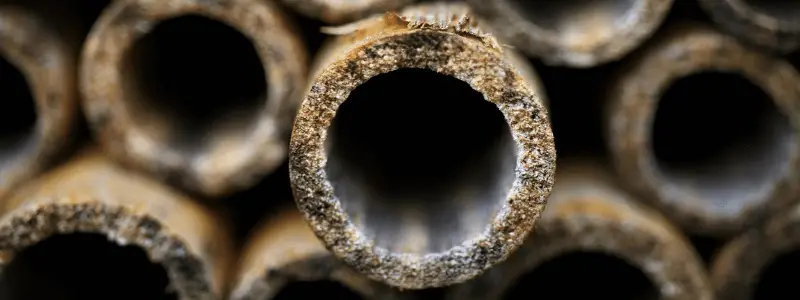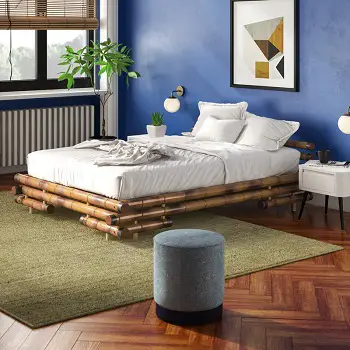Healthy bamboo plants are resistant to diseases and pests. However, you can occasionally find some discolorations and spots on the canes, thus indicating a problem. However, this is a cause for no alarm as you can easily prevent bamboo plant diseases than cure them.
For a healthy bamboo plant to thrive, you need good water management, enough moisture supply, good soil drainage. It will prevent the soil from being soggy for an extended period. Soils that organically rich are good in regulating soil moisture. Bamboos should be planted in a location with bright sunlight as it promotes vigor and good health.
A well-appearing bamboo plant can be affected by mold and even be damaged. Therefore, it is essential to get rid of the mold early before becoming rigid and hard to remove. It is wise to identify the bamboo plant problem before treating the mold, fungi, or another disease.
Since bamboo is not affected by many conditions, it is easy to determine what affects the plant.
Apart from the mold and fungi, bamboo grass is affected by the bamboo mosaic virus. It is eliminated by pruning and disinfecting the shears used for pruning to prevent spreading the disease.
As we explore further, the following are some of the mold and fungi that affect bamboo:
Fungal Spots
There are fungal spots on older bamboo plants and look like rust. The spots are around the canes and common in humid climates.
You can treat the fungal spots with copper-based fungicide. In cases where the fungal spots are in old plants, you can dull them and make room for younger plants.
Rot Issues
Bamboo roots often get the heart rots and root rots, a fungus that lives in any part of the bamboo stems. The Root rot affects the lower part of the stem and the roots.
These two types of corrosion can are accompanied mainly by mushrooms that grow on the soil or at the base of the bamboo plant.
It is hard to cure the root rot ad it can quickly kill the plants. So, the best solution is to remove all the roots to prevent the disease from spreading to other plants.
Sooty Mold
The sooty mold is a kind of mold that is caused by tiny sucking insects like aphids, scale, and mealybugs. These insects feed and excrete honeydew which is a sticky substance. The honeydew is soon infested with sooty mold fungus and leaves hidden black spots.
You can wash off the black spots, but since the insects keep infesting, it returns continuously. You can use insecticide oils and soaps to get rid of the insects regularly until the insects disappear. Ensure you follow the guidelines on the label when using the oils and the soaps.
Bamboo canes’ surface is commonly affected by mold, spores, and mildew, especially if the bamboo product is not 100% dry.
It is also common when bamboo products are shipped overseas in ocean freight containers. Even dry and well-treated bamboo poles at times suffer from surface mold.
Does Bamboo Mold in the Shower?
Some of us love to use bamboo in the bathroom. Some popular examples are shower stools, bathtub caddies and trays, floor mats, and accessories sets. People often wonder if their bamboo will mold in the shower.
Bamboo home decor designed for the bathroom will not mold in the shower. The bamboo furniture and accessories are coated in a wax sealant that prevents molding. Bamboo can develop mold if it is left soaking in water for long periods of time.
For example, a bamboo shower mat is resistant to both water and mold. If left soaking in a puddle of water for hours, even days, the wax coating will begin to dissolve and all for mold to set in.
Always remember to shake or wipe off water from your bamboo used in the shower. That includes shower benches, bathtub caddies, floor mats, and accessories

Types of Molds that Attack Bamboo
Surface Molds
These bamboo molds usually grow on the bamboo surface and the ends of the culms. The surface molds do not influence the bamboo strength and can easily be wiped off.
Stain Fungi
It can penetrate round bamboos from the cross-cut ends and the cuts on the nodes once the branches are removed. You can identify the infection by seeing blue or graying back shades discoloring the surface.
It comes in the form of spots and streaks. Except in severe cases, this fungi does not affect the strength of the bamboo though it reduces the aesthetic appearance of bamboo.
Decay Fungi
This causes the most severe damage to bamboo as it grows inside the lumen of the cells. It leaves behind the lignin and leads to brown or white rot. It is hard to detect at the early stages.
Early damage is seen when the bamboo becomes damp, and deterioration continues when the culm becomes soft to the touch and turns to powdery or fibrous mass.
Causes of Bamboo Fungi and Mold
Carbohydrates
Fungus comes from very fine air-borne spores found in fruit bodies, causing bamboo degradation. The fungus feeds on the starch and other sugar in the bamboo culms.
As they advance in growth, the damage starts manifesting on the bamboo surface.
Moisture Content
Fungi thrive in humid environments with a moisture of 40 to 80%.
Oxygen
Fungus needs to breathe just like any other living thing. As long as the presence of moisture is high, the fungi will always survive.
Is Bamboo Mold Dangerous?
Yes. Bamboo mold is dangerous to the bamboo grass, and bamboo products like furniture, bathtub, bamboo fence, toothbrush, dish racks, steam baskets, and others do get mold on their surface.
However, it can be once or twice until the excessive mold inside the bamboo product has evaporated completely.
Different bamboo species are treated in another way. For instance, Phyllostachys urea is regularly treated using heat treatment using a flame torch, while the thicker bamboo canes like Guadua Angustifolia are treated with boron solution.
The heat treatment is mainly done on green bamboo grass, leaving a high moisture content in the canes. In addition, the heat treatment affects the finished products positively as they become more sensitive to mold forming.
How to Treat Bamboo Mold?
The best and most effective method of cleaning mold on bamboo is using the Mold Armor FG502 product. There are other alternative methods like using vinegar or lemon oil.
The steps to follow are simple:
- Use a soft brush and clean the bamboo mold, mildew, and white spores and clean the area with a damp cloth. Then use the vinegar mixed with water or lemon oil to remove the mold.
- If you are cleaning bamboo furniture, apply at least three coats of polyurethane after removing the mold. You will need to commit time to this, but your furniture will be well conserved afterward.
- Always clean the furniture with turpentine and ensure it dries up completely. If it is not well dried, the mold will start growing underneath the polyurethane finish causing blisters.
Summary
The bottom line is bamboo does get mold, whether in plant mode or product mode. All one needs to do is follow the steps above, and you are good to go.
Of course, you don’t want to spend time planting bamboo grass and harvest nothing. For those in love with bamboo products, especially home decor, ensure you always have vinegar to keep your furniture mold-free and attractive.
Bamboo Group is a collaboration of individuals who love the world’s most sustainable and eco-friendly natural material. We believe every home can benefit from the natural colors and patterns of bamboo. We’re excited to see bamboo grow in popularity and get the recognition it deserves. Years of experience growing bamboo plants have taught us a lot we want to share with the world.




